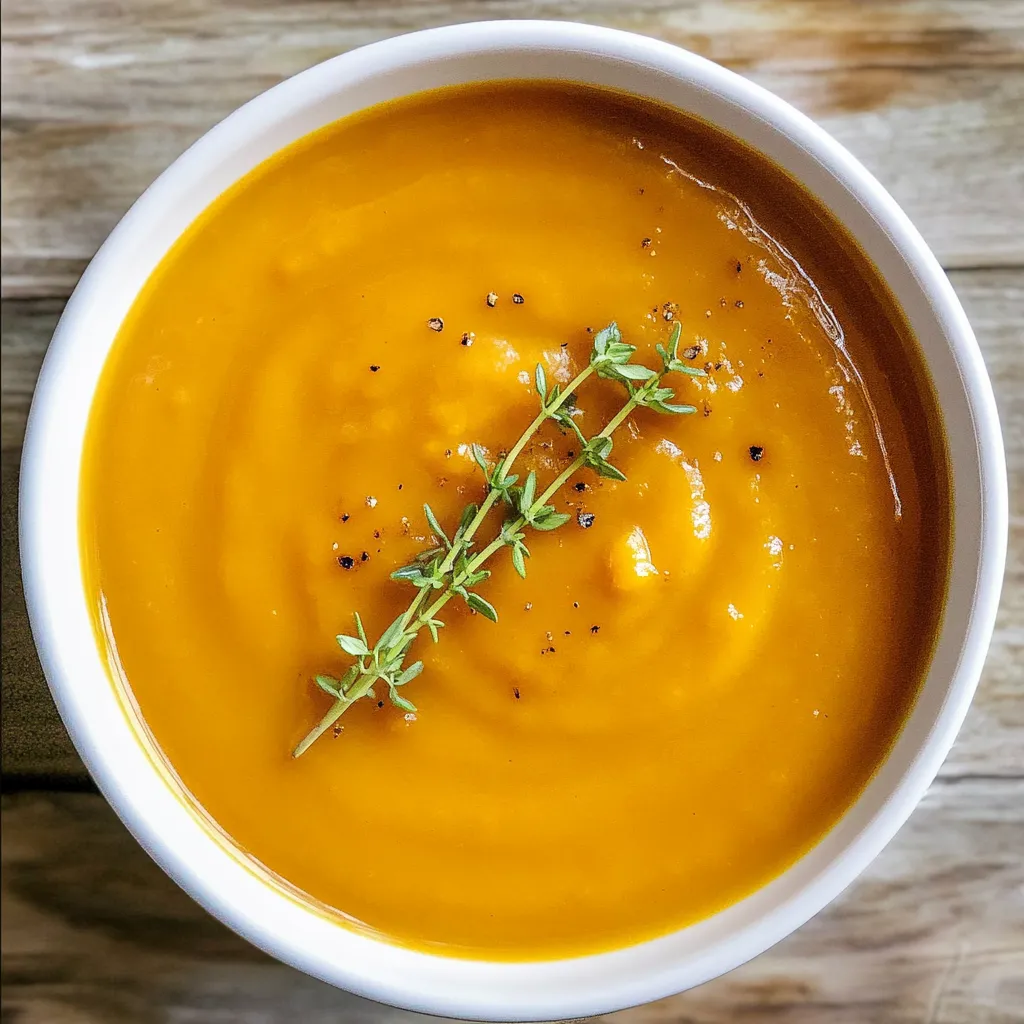 Pin it
Pin it
This silky pumpkin soup captures everything wonderful about fall in a single bowl. Roasted winter squash creates an incredibly rich, velvety base that gets enhanced with warm curry spices and creamy coconut milk for depth without any dairy. The combination of sweet roasted squash with aromatic ginger, turmeric, and cumin creates a soup that's both comforting and sophisticated enough for entertaining.
I fell in love with this approach to pumpkin soup after years of making bland, one-dimensional versions. The breakthrough came when I started roasting the squash instead of just boiling it, which concentrates the natural sugars and creates that deep, sweet flavor that makes all the difference. Adding curry spices was inspired by a trip to an Indian restaurant where I tasted a similar soup, and I knew I had to recreate those warm, aromatic notes at home.
Essential Ingredients and Selection Tips
- Fresh winter squash: Choose kabocha, butternut, or red kuri squash that feels heavy for its size with hard, unblemished skin
- Full-fat coconut milk: The richness is essential for proper texture; light coconut milk will make the soup thin and watery
- Fresh aromatics: Use fresh ginger root and garlic cloves rather than powdered versions for the most vibrant flavor
- Quality curry spices: Whole spices that you grind yourself taste much better than pre-ground, but fresh ground spices are acceptable
- Good vegetable broth: Use low-sodium so you can control the salt level; homemade always tastes better than store-bought
- Apple cider vinegar: This specific acid balances the sweetness better than other vinegars
Detailed Step-by-Step Instructions
- Roast the squash to perfection:
- Preheat your oven to 400°F and line a large baking sheet with parchment paper. Using a sharp, heavy knife, carefully cut your 3-4 pound squash in half lengthwise - this can be challenging, so take your time and keep your fingers clear of the blade. Use a sturdy spoon to scoop out all the seeds and stringy pulp from the center cavity. Brush the cut surfaces generously with olive oil, then season with salt and pepper. Place the halves cut-side down on your prepared baking sheet.
- Monitor the roasting process carefully:
- Roast the squash for 40-60 minutes, depending on size and variety, until the flesh is completely tender when pierced with a fork. The skin should give easily when pressed, and a knife should slide through the thickest part without resistance. Kabocha squash typically takes the full hour, while butternut squash may be done in 45 minutes. Let the squash cool until you can handle it safely.
- Prepare the squash flesh properly:
- Once cool enough to handle, use a large spoon to scoop the soft flesh away from the skin. You should be able to remove it in large chunks that hold together. Measure out exactly 4 1/2 packed cups of squash flesh, pressing it down gently in your measuring cup to remove air pockets. Save any extra squash for another use - it's delicious mashed as a side dish.
- Build the flavor base:
- Heat 2 tablespoons olive oil in a large, heavy-bottomed pot over medium heat. Add 1 diced medium onion and cook for 5-7 minutes, stirring occasionally, until softened and translucent but not browned. Add 3 minced garlic cloves, 1 tablespoon freshly grated ginger, 1 teaspoon ground turmeric, 1 teaspoon ground cumin, 1/2 teaspoon ground coriander, and 1/4 teaspoon ground cardamom. Stir constantly for 30-60 seconds until the spices are fragrant and lightly toasted.
- Combine and simmer thoroughly:
- Add your measured squash flesh to the pot along with 3 cups vegetable broth and one 14-ounce can of full-fat coconut milk. Stir everything together, breaking up any large chunks of squash with your spoon. Bring the mixture to a gentle boil, then reduce heat to maintain a steady simmer. Cook for 20 minutes, stirring occasionally, to allow all the flavors to meld and the squash to break down further.
- Blend to silky smoothness:
- Remove the pot from heat and stir in 1 tablespoon apple cider vinegar. Allow the soup to cool for 10-15 minutes to prevent dangerous splattering when blending. Working in batches if necessary, transfer the soup to a high-powered blender and puree until completely smooth. For safety, never fill the blender more than halfway with hot liquid, and always hold the lid down with a kitchen towel while blending.
- Perfect the consistency:
- Return the blended soup to your pot and assess the thickness. The consistency should coat the back of a spoon but still pour easily. If it's too thick, gradually whisk in additional vegetable broth or water, 1/2 cup at a time, until you reach your desired consistency. If it's too thin, simmer uncovered for a few minutes to reduce and concentrate the flavors.
- Season and serve with finesse:
- Taste the soup and adjust seasoning with salt, pepper, and additional apple cider vinegar as needed. The soup should have a perfect balance of sweet, savory, and slightly tangy flavors. Ladle into warmed bowls and garnish with a swirl of coconut milk, toasted pepitas, fresh cilantro, or a sprinkle of freshly ground black pepper.
 Pin it
Pin it
This soup has become my signature fall dish because it perfectly embodies the season while being sophisticated enough for dinner parties. The first time I served it to guests, I was nervous about the curry spices being too bold, but everyone raved about how the warming spices made it so much more interesting than regular pumpkin soup. Now I make double batches and freeze portions for quick weeknight dinners throughout the winter months.
Understanding Squash Varieties and Their Characteristics
Different winter squashes bring unique qualities to soup-making. Kabocha squash offers the sweetest, most intense flavor with a creamy texture that creates naturally thick soups. Butternut squash provides reliable results with good sweetness and smooth texture. Red kuri squash has a nutty undertone that adds complexity. Avoid acorn squash, which can be stringy, and large carving pumpkins, which are bred for size rather than flavor.
The Role of Roasting in Flavor Development
Roasting transforms the natural sugars in winter squash through caramelization, creating deeper, more complex flavors than steaming or boiling. The high heat drives off excess moisture while concentrating the natural sweetness. This process also breaks down the cell walls more effectively, resulting in a smoother final texture when blended. The cut-side-down method creates steam that helps cook the flesh evenly while the bottom caramelizes.
Spice Combinations and Flavor Balance
The curry spice blend in this soup creates warmth without overwhelming heat. Turmeric provides earthiness and that gorgeous golden color, while cumin adds depth and slight smokiness. Ginger brings brightness and gentle heat, coriander contributes citrusy notes, and cardamom adds subtle floral complexity. Toasting these spices briefly in oil awakens their essential oils and creates more vibrant flavors.
Blending Techniques for Safety and Smoothness
Hot liquids expand when blended, which can cause dangerous eruptions if the blender is overfilled. Always work in batches with hot soups, filling the blender no more than halfway. Starting on the lowest speed and gradually increasing prevents splattering. An immersion blender works well for this soup but may not achieve the same silky smoothness as a high-powered countertop blender.
Storage and Reheating Best Practices
Pumpkin soup thickens considerably when refrigerated as the starches continue to absorb liquid. When reheating, always add liquid gradually while stirring to prevent scorching. The soup freezes beautifully for up to three months, but the texture may separate slightly when thawed - simply whisk vigorously or blend briefly to restore smoothness. Avoid boiling when reheating, as this can cause the coconut milk to curdle.
This recipe represents everything I love about seasonal cooking - taking advantage of peak ingredients and transforming them through simple techniques into something that truly captures the essence of the season. The warming spices make it feel like a hug in a bowl, while the elegant presentation makes it suitable for both casual family dinners and formal entertaining. It's become my go-to recipe for using up the abundance of winter squash from our local farmers market.
Frequently Asked Questions
- → Can I use butternut squash instead of kabocha?
- Yes! Butternut squash works great, along with buttercup or red kuri squash. The cooking time stays the same.
- → How do I know when the pumpkin is done roasting?
- The flesh should feel very soft when you press it gently. This usually takes 40-60 minutes at 400°F.
- → Can I make this soup ahead of time?
- Absolutely! It keeps in the fridge for up to 4 days and tastes even better the next day.
- → What if my soup turns out too thick?
- Just add water a half cup at a time until you get the consistency you like. You can add up to 1½ cups total.
- → Is this soup really vegan and dairy-free?
- Yes! We use coconut milk instead of cream, making it completely plant-based and dairy-free.
- → Can I freeze leftover pumpkin soup?
- Yes, it freezes well for up to 3 months. Thaw overnight in the fridge and reheat gently on the stove.
